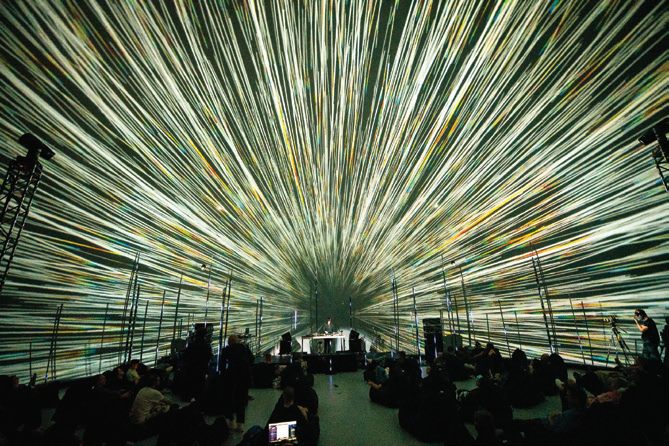
Employing A New Tool
With its 360-degree surround dome for video projection, the Satosphere at SAT is designed to provide a singular experience for audiences. Here, capacity was limited to only 50 people, with physical distancing assured by the fact they were seated on beanbag chairs spread widely around the venue.
Video projection and audience placement had an impact on the system design, requiring a ground-stacked PA approach with relatively few boxes to avoid blocking the dome, but one that would still provide substantial punch, particularly in the low end. With the audience seated essentially on the floor and the low/mid vibrating directly into their bodies, however, at times those mixing the show had to ask performers to dial back the low frequencies coming from onstage.
One Wave responded with a design utilizing four-module Meyer Sound LEOPARD arrays (left and right), on the ground and each atop a 900 LFC element. Three more 900-LFCs in the room delivered added low-end reinforcement, and eight ULTRA-X40 loudspeakers spread around the room delivered surround.
MAPP 3D, the company’s new prediction software, aided in helping to deliver high-resolution audio at both venues, with the systems managed and controlled by GALAXY processors. And as previously noted, Meyer Sound’s new Spacemap GO for iPad — a spatial sound design and mixing tool that leverages the GALAXY platform — also took a big role in SAT. The free app is designed to provide smaller venues, normally mounting less sophisticated productions, with an adaptable tool to create an immersive experience at a lower cost. (MUTEK deployed a late pre-release version of the platform.)

Essentially, it allows users to direct the path a given signal travels around a space via maps drawn on an iPad (or multiple iPads). The maps may conform closely to the existing loudspeaker layout, but they don’t have to, explains Meyer Sound technical support specialist Josh Fehrmann: “The platform has existed in various forms for roughly two decades, but with Spacemap GO we really focused on ease of use.”
For setup, he continues: “You just update the firmware on GALAXY, name the GALAXY, enter Spacemap mode, and use the app to configure the system on an iPad. After determining which inputs and GALAXY units you’re going to use, he continues: “You press one button and all of the inner linking and connecting is done automatically.”
In addition, specific channels can be set so they’re not effected by the software at all. And, for those looking to program shows ahead of time, he adds: “You can do that with Spacemap GO off-line and virtually, by creating an instance of GALAXY in Virtual Compass and doing all mapping and programming outside the venue.”
In further describing the platform, Ferhmann explains that users can overlay multiple maps in the app, similar to the way “layers” are used in Photoshop. In a venue with a ceiling distributed audio system and a live PA system, for example, one map could be assigned to the ceiling loudspeakers and another to the remaining system elements. And all maps can be altered in real time, with audio trajectories consisting of virtually any shape.
The deployment of Spacemap GO at MUTEK – and at various other events globally – was part an effort to solicit feedback to fine-tune the software before its late October release with an eye to making it more flexible for on the fly work in a live setting. Among the tweaks were the introduction of controls enabling users to lock down solo buttons so they can’t be accidentally triggered in a live show.

Other system elements at SAT included another SD11 console for front of house and monitors as well as eight channels of Clear-Com FreeSpeak II wireless intercom for communications between the multiple camera operators and producers filming the livestream.
Hands-On Experiences
While pre-programmed maps were created in Spacemap GO for incoming engineers to use, they were also encouraged to create their own. Initially there was some reluctance, notes Mathieu Parisien, the long-time front of house mixer for Patrick Watson, one of few acts playing with a full band and using its own console (a Soundcraft VI1).
“Patrick was performing some new material for the first time,” Parisien says, adding that because he was less familiar with that material, and setup time was limited, he wasn’t inclined to dive too deeply into Spacemap GO right off the bat. “But I did use the preset maps and created a map combining elements of two of them, which made the sound surround the room slowly before going into a ‘ping pong’ pattern. I was actually surprised at how easy it was to use and really enjoyed using it.”
Sam Dieulangard, MUTEK’s house audio engineer at SAT, spent more time with the software, explaining, “Often, I was only receiving a stereo mix, but there were exceptions to that and I used Spacemap GO in both situations every night.” He created several maps, including a circular one that moved the sound slowly around the room clockwise, and then a counter-clockwise spiral effect. “And I hadn’t heard the artist’s music before the show so I was blending the two of them to fit the music on the fly,” he adds.
MUTEK 21 may have been a different affair than usual, but in dealing with less-than-ideal circumstances, organizers see opportunities for innovation that will inform future events in Montreal as well as those that have yet to take place in 2020.
“The challenge is always, how can we be more creative and exploratory?” Mongeau concludes. “In December we have a collaboration between Tokyo and Mexico. MUTEK in Mexico usually happens in November and in Tokyo in December, but this year they’ve decided to join forces for a joint hybrid event, with some performances in Mexico, some in Japan and the merging of those efforts in the virtual platform.”
